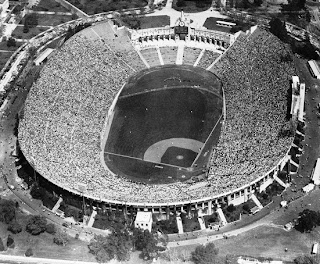The Coliseum is Wally’s park.
Vin
Scully (who also coined the term Moon
Shot)
“Why
Wally Moon?” my wife asked.
In
the seventeen years I’ve known her, including the thirteen we’ve been married,
I must have mentioned Wally’s name five-hundred times, easily. This marks the first occasion, however, in
which she actually wants to understand my mania.
Her
sincerity startles me and, to be honest, for a moment my ego feels a bit
deflated. During all this time, have I
been talking to the wall about my admiration for Wally Moon? The disappointment only lasts a couple of
seconds, though, because this benign obsession is one of my
favorite topics of discussion.
As
I prepare to answer the question, my mind reaches back to another era and
place: the Dodgers’ arrival in California and their years playing in the Los
Angeles Memorial Coliseum.
My
first memories of baseball date back to 1958, but my recollections as a four-year-old
only involve the rich aroma of cigars and the sight of a grayish-blue cloud of
smoke hovering above a sea of fedoras as the Dodgers play on a lush green field
below.
My
family lived within walking distance of the Coliseum, where the Dodgers played during
their first four years on the west coast.
General admission—the seats furthest away from home plate—cost $1 for adults
and .25 ¢ for children. Overnight, my
father, a baseball fanatic, thought he had gone to sleep and woken up in
heaven. We seldom missed a home game,
and although at that young age I didn’t have a clue as to the drama taking place
on the field, I enjoyed the atmosphere and the reactions of fans.
With
each passing game, however, my passion for baseball and the Dodgers grew. Within a couple of years I had learned the
names of all the team members and, as a faithful collector of baseball cards, I
had memorized their statistics.
My
favorite Dodger, by far, was Wally Moon.
Why
Wally Moon?
A
lot of it has to do with place.
Wally,
the 1954 National League Rookie of the Year, played his first four seasons with
the St. Louis Cardinals before they traded him to the Los Angeles Dodgers, in
1959. In his first year as a Dodger, he
became the spark the team needed to take the team from a dismal 1958 season to 1959
World Champions. But what made me a diehard
fan—and created thousands of others as well—were his Moon Shots. These gravity-defying launches off Wally’s
bat made the Coliseum his park.
The
Los Angeles Memorial Coliseum, constructed to host the 1932 Olympics, is
ideally suited for football and track and field. Baseball, however, is an awkward fit. The stadium’s unyielding oval shape placed
the left field fence at only 251 feet from home plate. A 42 foot-high screen had
to be raised to stop every fly ball from becoming a home run. (To compare: the Red Sox’s legendary Green
Monster is 310 feet from the plate and the wall stands at 37 feet.)
A
left-handed hitter, as well as something of a scholar, Wally assessed the
situation as soon as he learned of the trade and, following the advice of Stan
Musial, his close friend and former Cardinal teammate, he modified his swing to
one he describes as “inside-out.” Although he was hitting against the grain in going to the opposite field, he soon mastered the Coliseum’s odd physical arrangement.
The Moon Shot
was a work of art, and I had the great fortune to witness many of them. I can still recall, and vividly, that when Wally
stepped up to the plate, with the exception of the occasional fan demanding a
Moon Shot, a reverential stillness would spread through the Coliseum, everyone hoping to see Wally loft the ball over the screen.
I’d
block out all distractions to concentrate on every pitch. What was fascinating to observe was Wally’s
ability to decide, in a fraction of a second, whether to go for a home run to left
field or not. When he did go for the
screen, the arc of his swing was discernibly different, and when he connected
well, the fans would hold their breaths as they watched the ball rise up and
up, like a pole-vaulter steadily ascending toward the top of the bar. Then, as the ball cleared the barrier, the crowd
would erupt in thunderous celebration, and I can still see myself leading the cheers.
That,
to an extent, answers my wife’s question.
To watch a Moon Shot was a wondrous experience—as close to rapture as
there is in sports. What’s more, today I
only have to close my eyes for a moment and, once again, I’m a boy seated in
the Coliseum stands watching a baseball come off Wally’s bat, climb toward the
heavens, and then gloriously descend on the other side of the screen.
* *
* *
Most novelists
are touchy when discussing future writing projects. I include myself among their ranks. We have a deep-seated fear, one that borders
on superstition, that if one speaks too much of a tale that has yet to be
written, its essence, like a genie whose bottle has been carelessly uncorked,
will vanish into an wraithlike realm of lost stories. It is better to keep the cork on until the novel
is well underway or, preferably, until it’s approaching the final draft.
Moon started to
write his memoirs at the urging of his children and grandchildren, who wanted
his story recorded for posterity. With
the assistance of co-author Tim Gregg, Wally completed the Herculean task of documenting
his life from the beginning, in Bay, Arkansas, to the present. Like a seasoned storyteller—his Masters in
Education from Texas A&M pays off handsomely here—he escorts readers
through his college years on a joint basketball and baseball scholarship; his
unorthodox rise through the minor leagues; and his twelve years in the majors with
the Cardinals and the Dodgers. Moon’s
accounts of playing alongside many immortals now entrenched in baseball’s
pantheon make for fascinating reading. Moreover, although the tone of his
narrative always remains respectful, his candor about the issues and people in
baseball—then and now—is remarkable.
Moon also writes
about his years beyond the sport, giving readers a rare glimpse into the
choices a former major-league player of his time could make once his days on the baseball
diamond have ended.
Moon Shots: Reflections of a Baseball Life will delight
every baseball fan. Followers of the Dodgers will be especially thrilled to get
a first-hand account of the team’s early years in Los Angeles. More important, however, will be the comfort one
gets from reading the tale of a man of great character: as a professional ballplayer,
Wally took his responsibility as role model for my generation seriously, and he
conducted himself accordingly. Considering today’s tormented world of sports,
this book will reassure readers that in spite of the temptations of celebrity, heroes
can remain noble, unspoiled persons.
At the peril of
jinxing the novel I hope to begin writing sometime next year, I will share this:
Moon Shots: A Reflection on a Baseball
Life is a godsend for me. For close
to twenty years I’ve toyed with a storyline for young readers that involves
growing up in Los Angeles during the 1961 Dodger season, their last in the
Coliseum. I will not say what the novel
is about (in large part because I’m not quite sure myself at this point), but
one thing is certain: Wally Moon will be an overarching presence from beginning
to end. Thanks to Moon Shots, I can now get the story straight.











